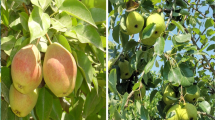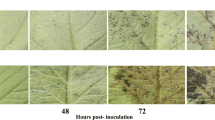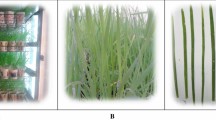Abstract
The resistant phenotype of pear cultivars includes either complete resistance or tolerance to the attack by the causative agent of fire blight. The effect of ferritin and active iron (Fe2+) concentrations was compared in resistant (Dargazi), tolerant (Harrow Sweet), and susceptible (Bartlett) pear cultivars inoculated with a wild type strain of Erwinia amylovora (Ea273). The examination of necrosis revealed that resistance to the disease manifested itself as a delay in the appearance of symptoms and progression of the disease. Despite a rise in ferritin levels in all cultivars following disease agent inoculation, resistant and tolerant cultivars showed greater ferritin levels than susceptible cultivar. In addition, only resistant and tolerant cultivars displayed a drop in Fe2+ levels. The rate of decrease in Fe2+ content in Dargazi and Harrow sweet cultivars was 28 and 33%, respectively. Hydrogen peroxide (H2O2) and hydroxyl radical (OH•−) accumulation and intensities were considerably distinctive. Furthermore, tolerant and sensitive cultivars started producing OH•− radicals faster than resistant cultivar. According to these findings, different pathways are employed by pear cultivars to respond to the causative agent of fire blight.









Similar content being viewed by others
References
Abdollahi H, Erfaninia K, Ghahremani Z, Nasiri J, Salehi Z (2017) Reactivation of electron flow in chloroplasts of in vitro shootlets of apple through elimination of carbon source and evaluation of its activity by inhibitors of electron transport chain and chlorophyll fluorescence quenching. Plant Cell, Tissue Organ Cult 131:377–389
Abdollahi H, Ghahremani Z (2011) The role of chloroplasts in the interaction between Erwinia amylovora and host plants. Acta Hort 896:215–221
Abdollahi H, Ghahremani Z, Erfani Nia K (2015) Role of electron transport chain of chloroplasts in oxidative burst of interaction between Erwinia amylovora and host cells. Photosynth Res 124:231–242
Abdollahi H, Rugini E, Ruzzi M, Muleo R (2004) In vitro system for studying the interaction between Erwinia amylovora and genotypes of pear. Plant Cell, Tissue Organ Cult 79:203–212
Asada K (2006) Production and scavenging of reactive oxygen species in chloroplasts and their functions. Plant Physiol 14:391–396
Azarabadi S, Abdollahi H, Torabi M, Salehi Z, Nasiri J (2016) ROS generation, oxidative burst and dynamic expression profiles of ROS-scavenging enzymes of superoxide dismutase (SOD), catalase (CAT) and ascorbate peroxidase (APX) in response to Erwinia amylovora in pear (Pyrus communis L). Eur J Plant Pathol 147:279–294
Baker CJ, Orlandi EW, Mock NM (1993) Harpin, an elicitor of the hypersensitive response in tobacco caused by Erwinia amylovora, elicits active oxygen production in suspension cells. Plant Physiol 102:1341–1344
Balint-Kurti P (2019) The plant hypersensitive response: concepts, control and consequences. Mol Plant Pathol 20:1163–1178
Barny MA, Guinebretière MH, Marcais B, Coissac E, Paulin JP, Laurent J (1990) Cloning of a large gene cluster involved in Erwinia amylovora CFBP 1430 virulence. Mol Microbiol 4:777–786
Bhattacharjee S (2010) Sites of generation and physicochemical basis of formation of reactive oxygen species in plant cell. Reactive Oxygen Species and Antioxidants in Higher Plants 1–30
Bogdanove AJ, Kim JF, Wei Z, Kolchinsky P, Charkowski AO, Conlin AK, Collmer A, Beer SV (1998) Homology and functional similarity of an hrp-linked pathogenicity locus, dspEF, of Erwinia amylovora and the avirulence locus avrE of Pseudomonas syringae pathovar tomato. National Academy of Sciences 95:1325–1330
Briat JF, Ravet K, Arnaud N, Duc C, Boucherez J, Touraine B, Cellier F, Gaymard F (2010) New insights into ferritin synthesis and function highlight a link between iron homeostasis and oxidative stress in plants. Ann Bot 105:811–822
Brisset MN, Paulin JP (1991) Relationships between electrolyte leakage from Pyrus communis and virulence of Erwinia amylovora. Physiol Mol Plant Pathol 39:443–453
Chamnongpol S, Willekens H, Moeder W, Langebartels C, Sandermann JH, Van Montagu M, Inze D, Van Camp D (1998) Defense activation and enhanced pathogen tolerance induced by H2O2 in transgenic tobacco. Proc Natl Acad Sci USA 95:5818–5823
Dat J, Vandenabeele S, Vranova E, Van Montagu M, Inze D, Van Breusegem F (2000) Dual action of the active oxygen species during plant stress responses. Cell Mol Life Sci 57:779–795
Deak M, Horvath GV, Davletova S, Torok K, Sass L, Vass I, Barna B, Kiraly Z, Dudits D (1999) Plants ectopically expressing the iron-binding protein, ferritin, are tolerant to oxidative damage and pathogens. Nat Biotechnol 17:192–196
DebRoy S, Thilmony R, Kwack YB, Nomura K, He SY (2004) A family of conserved bacterial effectors inhibits salicylic acid–mediated basal immunity and promotes disease necrosis in plants. PNAS USA 101:9927–9932
Dellagi A, Brisset MN, Paulin JP, Expert D (1998) Dual role of desferrioxamine in Erwinia amylovora pathogenicity. Mol Plant-Microbe Interact 11:734–742
Dutta Gupta S (2011) Reactive Oxygen Species and Antioxidants in Higher Plants. CRC Press, USA
Erfaninia K, Abdollahi H, Khosroshahli M (2014) Effect of several chloroplast electron transport chain inhibitors on interaction of Erwinia amylovora with susceptible and tolerant apple and pear cultivars. Plant Pathol 49:201–214 ((In persion))
Erfani J, Abdollahi H, Ebadi A, Fatahi Moghadam MR, Arzani K (2013) Evaluation of fire blight resistance and the related markers in some European and Asian pear cultivars. Seed and Plant Improvement Journal 29–1:659–672 ((In Persian))
Expert D, Dellagi A, Kachadourian R (2000) Iron and fire blight: role in pathogenicity of desferrioxamine E, the main siderophore of Erwinia amylovora. In: Vanneste J. _ed._, Fire Blight. The disease and its causative agent, Erwinia amylovora. CAB Int., New York, pp 179–195
Filek M, Walas S, Mrowiec H, Rudolphy-Skorska E, Sieprawska A, Biesaga-Koscielniak J (2012) Membrane permeability and micro and macro element accumulation in spring wheat cultivars during the short-term effect of salinity- and PEG-induced water stress. Acta Physiol Plant 34:985–995
Foyer CH, Leadis M, Kunert KJ (1994) Photo oxidative stress in plants. Plant Physiol 92:696–717
Fuentes G, Talavera C, Oropeza C, Desjardins Y, Santamaria JM (2005) Exogenous sucrose can decrease in vitro photosynthesis but improve field survival and growth of coconut (Cocos nucifera L.) in vitro plantlets. In vitro CEll Dev Biol Plant 41:69–76
Gaudriault S, Malandrin L, Paulin JP, Barny MA (1997) DspA, an essential pathogenicity factor of Erwinia amylovora showing homology with AvrE of Pseudomonas syringae, is secreted via the Hrp secretion pathway in a DspB dependent way. Mol Microbiol 26:1057–1069
Gerami E, Hassanzadeh N, Abdollahi H, Ghasemi A, Heydari A (2013) Evaluation of some bacterial antagonists for biological control of fire blight disease. J Plant Pathol 95:127–134
Halliwell B, Gutteridge JM (2015) Free radicals in biology and medicine: Oxford University Press, USA
Hassani M, Salami SA, Nasiri J, Abdollahi H, Ghahremani Z (2015) Phylogenetic analysis of PR genes in some pome fruit species with the emphasis on transcriptional analysis and ROS response under Erwinia amylovora inoculation in apple. Genetica 1–14
Hegeduse A, Erde S, Janda T, Szalai J, Dubits D, Horrath G (2002) Effects of low temperature stress on ferritin or aldose reductase overexpressing transgenic tobacco plants. Acta Biol Szeged 46:97–98
Holtappels M, Noben GP, Van Dijck P, Valcke R (2018) Fire blight host-pathogen interaction: proteome profiles of Erwinia amylovora infecting apple rootstocks. Sci Rep 8:11689
Katyal JC, Sharma BD (1980) A new technique of plant analysis to resolve iron chlorosis. Plant Soil 55:105–119
Kieu NP, Aznar A, Segond D, Rigault M, Simond-Côte E, Kunz C, Soulie MC, Expert D, Dellagi A (2012) Iron deficiency affects plant defense responses and confers resistance to Dickeya dadantii and Botrytis cinerea. Mol Plant Pathol 13:816–827
Kim JF, Beer SV (1998) HrpW of Erwinia amylovora, a new harpin that contains a domain homologous to pectate lyases of a distinct class. J Bacteriol 180:5203–5210
Klein SM, Cohen G, Cederbaum AI (1981) Production of formaldehyde during metabolism of dimethyl sulfoxide by hydroxyl radical-generating systems. Biochemistry 20:6006–6012
Krasuska U, Gniazdowska A (2012) Nitric oxide and hydrogen cyanide as regulating factors of enzymatic antioxidant system in germinating apple embryos. Acta Physiol Plant 34:683–692
Karuppanapandian T, Moon JC, Kim C, Manoharan K, Kim W (2011) Reactive oxygen species in plants: their generation, signal transduction, and scavenging mechanisms. Aust J Crop Sci 5:709–725
Lamb C, Dixon RA (1997) The oxidative burst in plant disease resistance. Annu Rev Plant Biol 48:251–275
Lescure A, Proudhon D, Pesey H, Ragland M, Theil EC, Briat JF (1991) Ferritin gene transcription is regulated by iron in soybean cell cultures. Proceedings of National Academy of Sciences of the United States of America (PNAS) 88:8222–8226
Lukac RJ, Aluru MR, Reddy MB (2009) Quantification of ferritin from staple food crops. J Agric Food Chem 57:2155–2161
Malnoy M, Venisse JS, Brisset MN, Chevreau E (2003) Expression of bovine lactoferrin cDNA confers resistance to Erwinia amylovora in transgenic pear. Mol Breed 12:231–244
Narayanasamy P (2008) Molecular Biology in Plant Pathogenesis and Disease Management: Disease Management. Springer Science & Business Media, Ordibehesht 10, 1387 AP-Science-249 pages
Oh CS, Beer SV (2005) Molecular genetics of Erwinia amylovora involved in the development of fire blight. FEMS Microbiol Lett 253:185–192
Oswald O, Martin T, Dominy PJ, Graham IA (2001) Plastid redox state and sugars: interactive regulators of nuclear-encoded photosynthetic gene expression. Proc Natl Acad Sci USA 98:2047–2052
Quoirin M, Lepoivre P (1977) Etude de milieux adaptes aux cultures in vitro de Prunus. Acta Hort 78:437–442
Paret ML, deSilva AS, Criley RA, Alvarez AM (2008) Ralstonia solanacearum race 4: risk assessment for edible ginger floricultural ginger industries in Hawaii. Hort Technol 18:90–96
Radwan DEM, Fayez KA, Mahmoud SY, Hamad A, Lu G (2006) Salicylic acid alleviates growth inhibition and oxidative stress caused by zucchini yellow mosaic virus infection in Cucurbita pepo leaves. Physiol Mol Plant Pathol 69:72–181
Radwan DEM, Fayez KA, Mahmoud SY, Lu G (2010) Modifications of antioxidant activity and protein composition of bean leaf due to Bean yellow mosaic virus infection and salicylic acid treatments. Acta Physiol Plant 32:891–904
Sambrook J, Russell D (2001) Molecular Cloning: A Laboratory Manual, 3rd edn. Cold Spring Harbor Laboratory Press, Cold Spring Harbor, NY
Sharma P, Jha AB, Dubey RS, Pessarakli M (2012) Reactive oxygen species, oxidative damage, and antioxidative defense mechanism in plants under stressful conditions. J Bot 2012:1–26. https://doi.org/10.1155/2012/217037
Taheri Shahrestani A, Abdollahi H, Yakhchali B, Mehrabi R, EiniGandomani O (2020) Determination of the role of HrpN effector protein, as a key factor in course of interaction between Erwinia amylovora with chloroplasts of pear (Pyrus communis L.). J Plant Pathol
Thordal-Christensen H, Zhang Z, Wei Y, Collinge DB (1997) Subcellular localization of H2O2 in plants. H2O2 accumulation in papillae and hypersensitive response during the barley-powdery mildew interaction. Plant J 11:1187–1194
van der Zwet T, Keil HL (1979) Fire blight: A bacterial disease of rosaceous plants. United State Department of Agriculture Handbook No 510. US Government Printing office, Washington DC, USA
Vanneste JL (2000) Fire Blight: The Disease and its Causative Agent. CABI Publishing, Wallingford, UK, Erwinia amylovora
Van Wuytswinkel O, Vansuyt G, Grignon N, Fourcroy P, Briat JF (1998) Iron homeostasis alteration in transgenic tobacco overexpressing ferritin. Plant J 17:93–97
Venisse JS, Barny MA, Paulin JP, Brisset MN (2003) Involvement of three pathogenicity factors of Erwinia amylovora in the oxidative stress associated with compatible interaction in pear. FEBS Lett 537:198–202
Venisse JS, Gullner G, Brisset MN (2001) Evidence for the involvement of an oxidative stress in the initiation of infection of pear by Erwinia amylovora. Plant Physiol 125:2164–2172
Wei ZM, Laby RJ, Zumoff CH, Bauer DW, He SY, Collmer A, Beer SV (1992) Harpin, elicitor of the hypersensitive response produced by the plant pathogen Erwinia amylovora. Science 257:85–88
Xie Z, Chen Z (2000) Harpin-induced hypersensitive cell death is associated with altered mitochondrial functions in tobacco cells. Mol Plant Microbe Interact 13:183–190
Xi L, Xu K, Qiao Y, Qu S, Zhang Z, Dai W (2011) Differential expression of ferritin genes in response to abiotic stresses and hormones in pear (Pyrus pyrifolia). Mol Biol Rep 38:4405–4413
Yabuta Y, Mieda T, Rapolu M, Nakamura A, Motoki T et al (2007) Light regulation of ascorbate biosynthesis is dependent on the photosynthetic electron transport chain but independent of sugars in Arabidopsis. J Exp Bot 58:2661–2671
Yadav K, Patel P, Srivastava AK, Ganapathi TR (2017) Overexpression of native ferritin gene MusaFer1 enhances iron content and oxidative stress tolerance in transgenic banana plants. PLoS One 12(11):e0188933. https://doi.org/10.1371/journal.pone.0188933
Acknowledgements
We thank Faezeh Ghanati and Zeinab Salehi for their technical assistance.
Author information
Authors and Affiliations
Corresponding author
Ethics declarations
Informed consent
All of the authors attest that the work done in this study adhered to ethical and professional standards. All authors planned the study for scientific research purposes alone, including data collection and analysis, publication decision, and article preparation. The author’s institutions have been notified.
Conflict of interest
All of the authors certify that they: 1) have no actual or potential conflicts of interest, 2) have not previously published the study and are not considering publishing it elsewhere, and 3) have followed all applicable local, national, and international regulations and conventions, as well as normal scientific ethical practices.
Human participants and/or animals
No specific permits were required for the described studies.
Additional information
Publisher’s Note
Springer Nature remains neutral with regard to jurisdictional claims in published maps and institutional affiliations.
Rights and permissions
About this article
Cite this article
Maleki, R., Abdollahi, H. & Piri, S. Variation of active iron and ferritin content in pear cultivars with different levels of pathogen resistance following inoculation with Erwinia amylovora. J Plant Pathol 104, 281–293 (2022). https://doi.org/10.1007/s42161-021-00998-9
Received:
Accepted:
Published:
Issue Date:
DOI: https://doi.org/10.1007/s42161-021-00998-9




